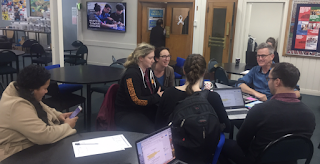"When asked why they took my class, 2 replied because it was the only option in the line they liked, 3 said because they wanted to try it out, and rest weren't sure why they'd taken my subject. Only 1 student had said it was part of his career pathway" (February, 2019)
Over the year, I have used engaging contexts and activities to motivate my students with their learning and to think critically about the social issues that they were learning about - the Tamaki Regeneration Company, the 40 Hour famine, Marriage amendment laws and Israel and Palestine (for the external). Having limited knowledge about what social studies is all about, I was hoping that their interest will grow if I exposed them to different learning environments.
I also used a variety of effective writing strategies to get them used to academic writing and to improve their confidence in writing. A workshop by Joseph Driesson on Improving boys' literacy skills helped kick off a drive to research effective practices. This was followed by a PLD opportunity with 'Write that Essay' taken by members of staff, who have shared effective strategies that we had trialled throughout the year. A focus on 'Language in Abundance' has allowed my students to use the 'Talanoa' to encourage my kids to make meaning of their learning through verbal and oral discussions. This has probably been the most effective strategy because my kids love to talk.
To measure whether my inquiry has made an impact in their achievement, I have looked at:
- Credits gained in their assessments
- Credits gained at merit/excellence level
- Literacy credits gained at the of the year
- Student voice surveys
(Note: These results are based on 8 remaining boys in the class)
Credits gained in their assessments, at merit/excellence level and in literacy.
My Reflection: I am pleased about the results overall as there has been a shift from 6 boys achieving credits in the first assessment to all 8 in the term 3 one. As shown by the table, there have been successes in the number of merits and excellences gained by the boys, but not a significant shift. This shows me that more work is needed to shift the achieved students to a merit or excellence grade.
Student voice surveys
I conducted a comprehensive student voice survey at the end of the term for my kids to sum up their experiences in the class for the year.
- Engaging Contexts
I asked the kids to rate the topics on a scale from 1 - 5, 1 being the least interesting, 5 being the most interesting. I then asked them to write why they put this grade on the scale.
- Effective writing strategies
I asked the kids to tell me whether they thought their writing had improved and 100% of them said that it had and they then identified which strategies may have helped the most.
My reflection: I can see the link between engagement and achievement in that the students that did not rate the first unit we did on the marriage laws highly - they then did not achieve as well as they could have. As we got to the next two units, there were lots of different activities and engaging tasks that I feel impacted positively on their learning and therefore led to good achievement in their assessment results. The more engaging a context is and the more a student can identify what helps them to write, the more they will invest in their learning and achieve better results. When asked whether they will take social studies again next year, 100% of them answered and told me they were bringing their other friends! I look forward to taking up the challenge again next year!
Next Steps: I want to continue to focus on raising the achievement of boys' writing because I feel is the biggest issue that needs to be addressed for our learners. I have enjoyed learning about the different ways that writing could be improved and find it rewarding to see the success of our boys when they write a great power sentence for example or they overcome the challenge of starting a paragraph. For my next inquiry, I want to explore the power of the 'Talanoa' further and sit down with Dr Jannie Van Hees to plan to develop our kids as informed conversationists, which I am excited about.


















































